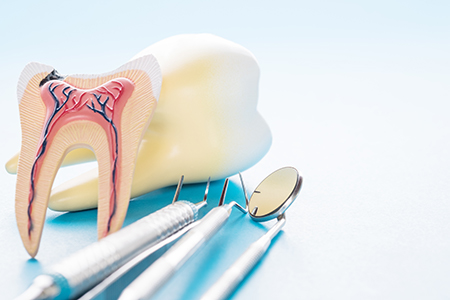If your dentist recommends a root canal, remain calm — modern endodontic treatment is designed to relieve pain and preserve teeth with minimal discomfort. In many cases, a root canal protects your natural tooth structure and restores function faster than extraction and replacement. The goal is straightforward: stop infection, save what remains of your tooth, and keep your smile healthy and natural.
At Chroma Dental, we combine up-to-date techniques with a patient-centered approach to make root canal therapy predictable and comfortable. Whether you arrive with a sudden toothache or a chronic problem that has slowly worsened, our priority is precise diagnosis, gentle care, and clear communication so you understand each step of treatment.
Keeping a natural tooth whenever possible preserves chewing efficiency, helps maintain neighboring teeth and bone, and supports a stable bite. Removing a tooth can create a cascade of changes — shifting teeth, altered chewing patterns, and bone loss over time — that often lead to more extensive restorative work down the road. Root canal therapy allows many compromised teeth to remain functional and esthetic for years.
Advances in instrumentation, filling materials, and sterilization have improved the long-term success of root canal treatment. Today’s techniques focus on thorough cleaning of the root canal space, sealing to prevent reinfection, and protecting the remaining tooth with a durable restoration. When combined with proper oral hygiene and follow-up care, a tooth treated with root canal therapy can serve you for a lifetime.
Choosing to preserve a tooth is also a conservative decision for your overall oral health. It avoids unnecessary removal of tooth structure elsewhere in the mouth and often spares patients the need for implants or bridges. Our team evaluates each case individually, weighing the tooth’s structural integrity, the amount of remaining bone support, and your personal health goals before recommending the best course.

Inside every tooth is a central pulp chamber that contains nerve tissue and blood vessels. When bacteria reach this area through deep decay, cracks, or trauma, the pulp can become inflamed or die. That process often leads to pain, swelling, or the formation of an abscess at the root tip. Early recognition and treatment limit the spread of infection and protect surrounding tissues.
Symptoms can vary. Some people experience sharp or throbbing pain that disrupts sleep, while others notice only lingering sensitivity to hot or cold. In other cases, a tooth may darken or show swelling near the gumline. X-rays and clinical testing are essential because some infected teeth produce surprisingly little discomfort yet show clear signs of disease on imaging.
When the pulp is irreversibly damaged, root canal therapy becomes the conservative option to remove infected tissue while preserving the tooth’s external structure. If ample tooth structure and bone support remain, a treated tooth can be restored and maintained for many years. Prompt professional evaluation is the best way to determine whether root canal treatment is appropriate.
Although not every toothache requires endodontic treatment, the following warning signs frequently indicate pulpal involvement:
Continuous, severe, or throbbing pain — particularly pain that wakes you from sleep — is a common indicator that the tooth’s internal tissues are compromised. This kind of persistent discomfort often warrants urgent assessment.
When sipping hot or cold drinks provokes prolonged sensitivity long after the stimulus is removed, it suggests inflammation or damage to the nerve inside the tooth. Acute thermal sensitivity is an early red flag.
Discomfort during chewing or when pressure is applied often points to inner tooth involvement or a developing infection. Patients sometimes describe this as discomfort on the tooth’s “bite.”
A tooth that darkens after injury or over time may have lost vitality. Internal staining or color change is a sign the pulp has been affected and should be evaluated.
Fractures that expose deeper layers of the tooth can allow bacteria to invade the pulp. Even a small crack can lead to significant internal damage if left untreated.
Localized swelling or an area that intermittently drains fluid points to an infection at the root tip or surrounding bone. These signs require timely care to prevent progression.
When infection affects the supporting bone, a tooth can become loose. Addressing the underlying cause often helps stabilize the tooth and halt further bone loss.

Delaying care can allow an infection to spread, increasing discomfort and risking damage to adjacent teeth and bone. In some cases, a tooth that might have been saved with an early root canal will require extraction if treatment is postponed too long. Quick diagnosis preserves options and typically leads to simpler, more predictable outcomes.
Routine dental exams and radiographs play a critical role in catching problems before they become severe. Some infected teeth produce few obvious symptoms yet reveal periapical changes on X-ray images. That’s why periodic professional evaluation is an essential part of maintaining long-term oral health.
Our approach is to weigh the benefits of saving a tooth against its long-term prognosis. When root canal therapy is recommended, we explain why it’s advised, what the procedure entails, and how a restoration afterward will protect the tooth. Timely action reduces the risk of complications and supports a reliable recovery.
Modern non-surgical root canal treatment is designed to be efficient and comfortable. After numbing the area, the dentist isolates the tooth and creates a small access opening to reach the pulp chamber. Using specialized instruments and magnification, the canals are cleaned to remove infected tissue and shaped to receive a filling material.
Disinfection is a critical part of the process. Contemporary techniques include irrigants and instruments that greatly reduce bacteria within the canal system. Once clean, the canals are filled with a biocompatible material that seals the space and prevents reinfection. Treatment is usually completed under local anesthesia, and sedation options are available for patients with anxiety.
Some cases are completed in a single visit; others require staged care when there is active infection or complex anatomy. After endodontic treatment, the tooth typically needs a definitive restoration — often a crown — to restore strength and function. This final step protects the tooth from fracture and helps ensure long-term success.

Following treatment, many patients notice immediate relief from the severe pain that led them to seek care. Some post-procedure soreness or mild tenderness around the tooth and gums is normal for a few days as tissues heal. Over-the-counter pain relievers are usually sufficient; your clinician will advise if stronger medication or antibiotics are appropriate.
While the temporary filling is in place, the treated tooth is more vulnerable to fracture. It’s wise to avoid hard or sticky foods and to chew on the opposite side until a permanent restoration is placed. Good oral hygiene — regular brushing and flossing — supports healing and reduces the risk of future problems.
Long-term success depends on restoring and protecting the tooth after root canal therapy. A well-fitted crown or other definitive restoration restores proper function and helps prevent reinfection. With appropriate follow-up and routine dental care, a tooth treated with endodontic therapy can provide many years of reliable service.
At our office, patient comfort and clear post-operative instructions are part of every visit. If you experience unusual or persistent symptoms after treatment, such as swelling or increasing pain, contact us so we can evaluate healing and provide prompt care.
With careful diagnosis, skilled treatment, and sensible follow-up, root canal therapy is a reliable way to relieve pain and preserve natural teeth. If you have questions about whether a root canal is right for you or want to learn more about our approach to endodontic care, please contact us for more information.
A root canal procedure is the best way to save a tooth that has been damaged by decay or injury and preserve your natural smile. The alternative is an extraction and treatment to replace the tooth. While at times a tooth is non-restorable and an extraction is the only option, when possible, it’s best to try and save your natural tooth. With proper care, a tooth with root canal therapy can serve your smile well for many years to come.
Despite lingering myths from before the age of modern dental anesthesia and technology, having a root canal procedure today is as routine and comfortable as visiting the dentist for a filling. While the procedure is performed under local anesthesia with your tooth completely numbed, we can also discuss options in dental sedation.
Whether the symptoms of a dental infection subside after a course of antibiotics, a draining abscess provides you with some temporary pain relief, or a tooth with radiographic evidence of pathology has not yet developed symptoms, it’s essential, before an infection worsens or occurs, to have a root canal procedure performed. In this way, the tooth can be disinfected, filled, and sealed to protect your health and avoid further problems.
If you have sustained a dental injury, have a toothache, jaw pain, swelling, or are experiencing any other unusual and uncomfortable oral symptoms, contact our office immediately for care. Dental problems that have not been evaluated and treated can significantly worsen, producing more severe damage and consequences for the involved teeth, your oral health, and even your overall wellbeing. Once you get in touch with our office, our friendly and compassionate office team will get you in for care at your earliest convenience.
While some root canal procedures can be completed in one visit, others may involve 2 or 3 appointments. How long it takes depends on various factors, including active infection, the number of canals in the tooth, and the tooth’s location or anatomy.
With a success rate that exceeds 95%, root canal therapy remains the most effective procedure to save a tooth in which the inner vital tissues have been damaged. However, as with all healthcare procedures, there are a small percentage of cases where the teeth become symptomatic a second time. The good news is that many of these teeth can still be saved with root canal retreatment or a minor surgical procedure known as an apicoectomy.
The best ways to maintain a tooth with root canal therapy are to get the proper restoration required to rebuild and protect the tooth, maintain proper oral hygiene, and schedule appointments for routine dental checkups and care.
Saving a tooth with root canal therapy is a wise investment that, in the long run, is typically less costly and invasive than having the tooth extracted and replaced with a fixed bridge or implant. As far as the exact cost of care, it can vary depending on which tooth is being treated. Many dental insurance plans provide coverage for root canal therapy. At the office of Chroma Dental, we do our best to optimize your dental benefits and minimize your out-of-pocket expenses. Our staff will answer all your questions about the cost of care and discuss all your payment options.
At the office of Chroma Dental, we use the latest technology and most effective methods of care to provide precise and gentle care. Our reputation for excellence is based upon a consistent record of achieving successful treatment outcomes while providing prompt, stress-free, and convenient treatment for every type of dental need.
